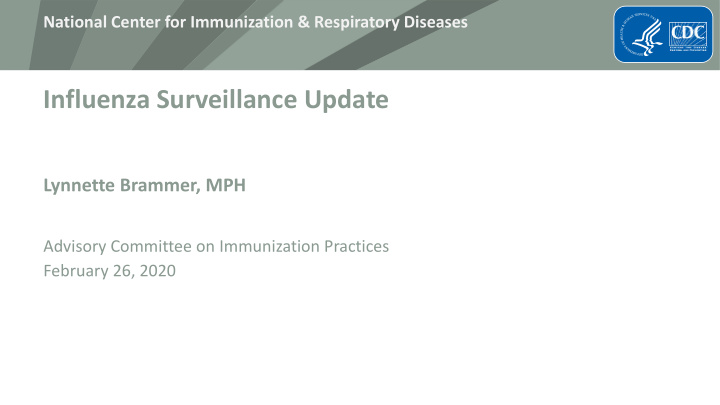



National Center for Immunization & Respiratory Diseases Influenza Surveillance Update Lynnette Brammer, MPH Advisory Committee on Immunization Practices February 26, 2020
Influenza Virologic Surveillance, 2019-2020 Season
Outpatient Visits for Influenza–like Illness 7.5%
Laboratory Confirmed Influenza-Associated Hospitalizations, FluSurvNet, 2019-20
Laboratory Confirmed Influenza-Associated Hospitalizations, FluSurvNet, 2019-20
Laboratory Confirmed Influenza-Associated Hospitalizations, FluSurvNet, 2019-20
Influenza-Associated Mortality
2019-20 Flu Season: Preliminary Burden Estimates www.cdc.gov/flu/
Characterization of U.S. Influenza A (H1N1)pdm09 Viruses Collected September 29, 2019 to Present All 563 influenza A (H1N1)pdm09 viruses tested belong to genetic group 6B.1A All 74 A(H1N1)pdm09 viruses antigenically characterized using a hemagglutination inhibition (HI) assay with ferret antisera were similar to the cell culture-propagated A/Brisbane/02/2018-like reference virus representing the 2019-20 Northern Hemisphere vaccine component
Characterization of U.S. Influenza A (H3N2) Viruses Collected September 29, 2019 to Present 365 of 381 (95.8%) A(H3N2) viruses belong to 3C.2a1 subclade 16 (4.2%) belong to 3C.3a clade 31 of 72 (43.1%) of A(H3N2) viruses antigenically characterized by FRA were well-inhibited by ferret antisera raised against A/Kansas/14/2017 (3C.3a), a cell-propagated reference virus representing the A(H3N2) component of 2019-20 Northern Hemisphere influenza vaccines.
Characterization of U.S. Influenza B Victoria Lineage Viruses Collected September 29, 2019 to Present Two genetic groups of B/Victoria lineage viruses are co-circulating, V1A.1 and V1A.3 – 50 of 655 (7.6%) B/Victoria lineage viruses belonged to the V1A.1 subclade, the remaining 605 belonged to the V1A.3 subclade – B/Colorado/06/2017, the reference virus representing the B/Victoria lineage virus in the 2019-20 Northern Hemisphere vaccines belongs to the V1A.1 subclade 53 of 88 (60.2%) B/Victoria lineage viruses antigenically characterized by HI using ferret antisera were similar to the cell-propagated B/Colorado/06/2017-like V1A.1 reference virus.
Characterization of U.S. Influenza B Yamagata Lineage Viruses Collected September 29, 2019 to Present All B/Yamagata lineage viruses tested belong to a single genetic group, Y3 All influenza B/Yamagata-lineage viruses antigenically characterized are similar to cell-propagated B/Phuket/3073/2013 (Y3), the reference vaccine virus representing the influenza B/Yamagata-lineage component of the 2019-20 Northern Hemisphere quadrivalent vaccines.
Vaccine Virus Selection for 2020-21 WHO Consultation on the Composition of Influenza Virus Vaccines for Use in the 2020-2021 Northern Hemisphere Influenza Season - February 24 – 28 March 4, 2020: FDA’s Vaccines and Related Biological Products Committee Meeting
Summary Influenza activity remains elevated Influenza B/Victoria lineage viruses predominated early in the season but A(H1N1)pdm09 viruses have increased in recent weeks. For the season overall approximately equal numbers of B/Victoria and A(H1N1) have been reported Overall severity has been low but hospitalization rates among children and young adults have been high. So far, 105 influenza-associated deaths in children have been reported
For more information, contact CDC 1-800-CDC-INFO (232-4636) TTY: 1-888-232-6348 www.cdc.gov The findings and conclusions in this report are those of the authors and do not necessarily represent the official position of the Centers for Disease Control and Prevention.
Recommend
More recommend